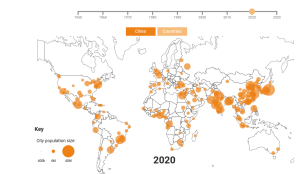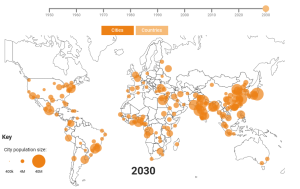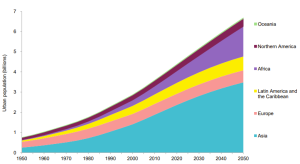World Urbanization
Cities now accommodate 56% of the world’s population. This trend is expected to continue, with the urban population more than doubling by 2050, when nearly seven out of ten people will live in cities. With cities accounting for more than 80% of global GDP, urbanization can contribute to long-term growth through increased productivity and innovation if properly managed (UN-Habitat, 2022). However, the speed and scale of urbanization pose challenges, such as meeting the accelerated demand for affordable housing, and viable infrastructure, including transportation systems, basic services, and jobs, especially for the nearly 1 billion urban poor who live in informal settlements to be close to opportunities. Rising conflicts add to the pressure on cities, as 50% of those forcibly displaced live in cities.
Smart-city interventions have emerged to address urbanization issues such as economic development and job creation, climate change, resource efficiency, equity, and citizen engagement. How can smart cities be related to the livability index, the UN SDGs, and overall development? In India, for example, smart cities are related not only to the SDG goals but also to the four pillars (institutional, social, economic, and physical) of comprehensive development. Smart cities combine infrastructure and technology to improve citizens’ quality of life and interactions with the urban environment. Smart cities unlock the potential for economic growth by integrating, regulating, optimizing, and controlling the city’s impact on communities and the natural environment. However, how can data from areas such as public transportation, air quality meters, and energy production be integrated and effectively used? The need for smart cities arose from a desire to improve the sustainability, efficiency, dependability, safety, and quality of services provided by our cities’ public operations, amenities, and assets (Vacca, 2021).
In Images 1,2 & 3 below, highlights of changes in urbanization can be seen from 1950 to 2030. The 200 largest cities in the world are represented by orange circles.
Image 1

Source: United Nations, 2018
Image 2

Source: United Nations, 2018
Image 3

Source: United Nations, 2018
In Figure 1, we can observe the growth of urban population by continent since 1950 and with a projection until 2050.
Figure 1

Source: United Nations, 2018
References
Vacca, J. (2021). Solving Urban Infrastructure Problems Using Smart City Technologies. In Handbook on Planning, Design, Development, and Regulation (p. 786). Elsevier.
UN-Habitat. (2022). World Cities Report 2022, Envisaging the Future of Cities. United Nations Human Settlements Programme
